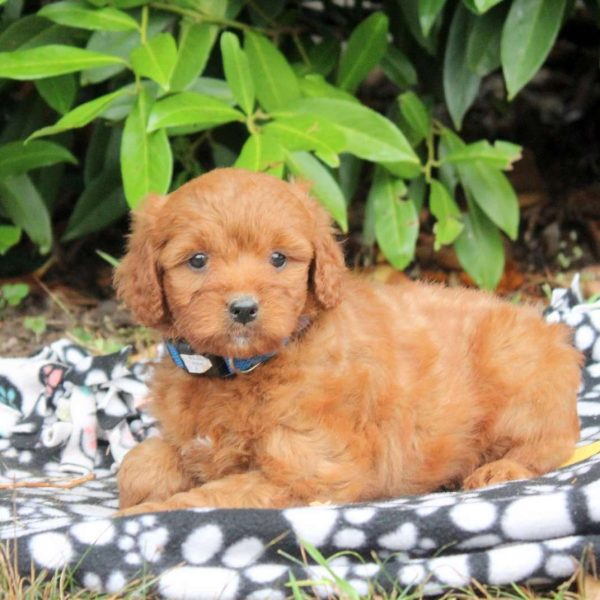
-
Activity Level:
moderate
-
Shedding Level:
low
-
Grooming Level:
low
-
Trainability:
high
-
Good for Novice Owners:
high
-
Adaptability:
high
-
Kid/Pet Friendly:
often
-
Prey Drive:
low
-
Watchdog:
aware
- Average Size: Small
- Average Lifespan: 10-15 Years
Golden Cavadoodle Dog Breed Information
Overview
Temperament
Adaptability
Health
Owner Experience
Grooming
Activity Level
Size
Life Span
Did You Know?
A Golden Cavadoodle is a cross between a Poodle, Golden Retriever, and Cavalier King Charles Spaniel. Usually, the parents are a Cavapoo and a Mini Goldendoodle. However, you can also get this cross when one of the parents is a Cavapoo, a Mini Goldendoodle, or a Golden Cavalier and the other parent is the “missing” breed in the desired trio.
Golden Cavadoodles are also referred to as Golden Cavapoos or Golden Cavoodles. With some of the most affectionate and friendly breeds in the cross, Golden Cavadoodles tend to be easygoing, playful, and sweet dogs that love being around their families.
With some of the most affectionate dog breeds as parents, it should be no surprise that Golden Cavadoodles are also establishing a reputation for being loving, cuddly, and very affectionate companions that bond closely with their families.
Well-socialized, these dogs also tend to get along well with children, other dogs, and other pets. Although they may bark to alert you of strangers, they also tend to be open and friendly with them provided they are well-socialized. They can be prone to barking a lot, especially if they have been accidentally trained into it. If you train your dog to stop barking early on, you can keep this from becoming a nuisance later.
Golden Cavadoodles are highly adaptable dogs. Although they can be quite energetic, they can adapt well to apartment living as long as they get enough daily exercise and attention. They also thrive in larger homes, especially those with fenced yards where they can run freely.
They do well in most climates. As with any dog, they are sensitive to heat. Although they can handle some cold, they are not a snow dog breed and may need some winter dog products to help keep them warm and protect their paws when out on winter walks.
Golden Cavapoos also bond closely with their families and thrive on attention and affection from them. Because of this, they do not like to spend long periods of time alone. They can also be prone to developing separation anxiety if you do not socialize and work with them early on.
Although mixed-breed dogs can be healthier than purebred dogs, it’s not a guarantee. They can inherit some, none, or all of the conditions common to their parent breeds. The health of the parents and good breeding practices make a big difference in the health of Golden Cavadoodle puppies.
Potential health concerns to be aware of in a Golden Cavapoo can include patellar luxation, Mitral Valve Disease, hip dysplasia, elbow dysplasia, cataracts, progressive retinal atrophy, Addison’s Disease, sebaceous adenitis, epilepsy, and subvalvular aortic stenosis.
Reputable breeders will screen their dogs to make sure they are not passing preventable issues to puppies, so make sure you are asking about the health and genetic history of both parents. You can also ask about any health tests or clearances that have been done.
The Golden Cavadoodle is intelligent and eager to please. They pick up on things quickly and are sensitive to their owners. Although they may try to tempt you with their cuteness to get away with things, overall, they do their best to meet your expectations. Clear, consistent training focused on positive rewards and praise is what these dogs respond to best.
With some of the best dog breeds for first-time owners as parents, you can bet a Golden Cavadoodle is also a good fit for owners of all experience levels. With these dogs, puppy training classes are more often used as opportunities to socialize a dog rather than actually needing them for training.
Although there can be some variation in the coat and some Golden Cavadoodle puppies may have a coat closer to one parent breed than another, they tend to have a silky and wavy coat like a Golden Retriever and Cavalier King Charles Spaniel or a tightly curled coat closer to a Poodle. Silky and wavy coats tend to be low-shedding while the tightly curled Poodle coat tends to be nonshedding.
Either way, you will need to brush your dog every day to remove tangles and prevent mats. Bathing at home is on an as-needed basis, and professional grooming is recommended approximately every 6-8 weeks. In addition to coat care, you will also need to take care of your Golden Cavadoodle’s nails, ears, and teeth.
Cutting nails once or twice a month is usually enough to keep them from growing too long. Weekly ear checks along with careful cleanings when needed can help prevent ear infections. Daily brushing and cleanings at the vet when needed are a good start for good dental care for dogs and can help prevent dental diseases later in life.
Golden Cavadoodles tend to be on the smaller side. Although there is always a chance a Golden Cavadoodle puppy could inherit the high energy of the Golden Retriever, they tend to sit in a more moderate activity range. They will certainly be energetic when they play, but daily walks and some extra activity throughout the day are usually enough for these little dogs.
They may be small, but they also tend to be athletic, so they may be up for more activity if you are. And, if you have active outdoor hobbies, your Golden Cavadoodle will usually be happy to join you. Just make sure puppies are finished growing and developing and are cleared by your vet for higher-impact activities and make sure your dog is not overexerting themselves trying to keep up with you.
Fully-grown Golden Cavadoodles usually stand 10-17 inches tall and weigh 15-35 pounds. There can be a lot of variation depending on the parent breeds in the cross for a specific litter, so make sure you talk to the breeder about the parents. You can also meet the sire and dam in person to get an idea of what size to expect in a fully-grown Golden Cavadoodle.
Golden Cavadoodles generally live for 10-15 years on average.
The coat of some Golden Cavadoodle puppies can fade to a lighter color as they grow to adulthood. This is due to a fading gene that is present in some Poodles. This is a recessive gene in some Poodles and is not harmful.
It does not cause health problems; it just causes fur color to lighten over time. It is difficult to predict how much lighter a coat may get over time in dogs with this gene. In some cases, it’s just a few shades lighter than their fur color as puppies while in others, their fur lightens to almost white.





